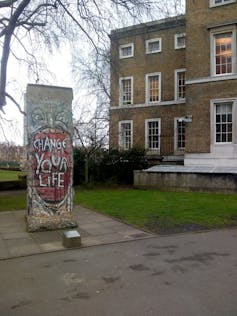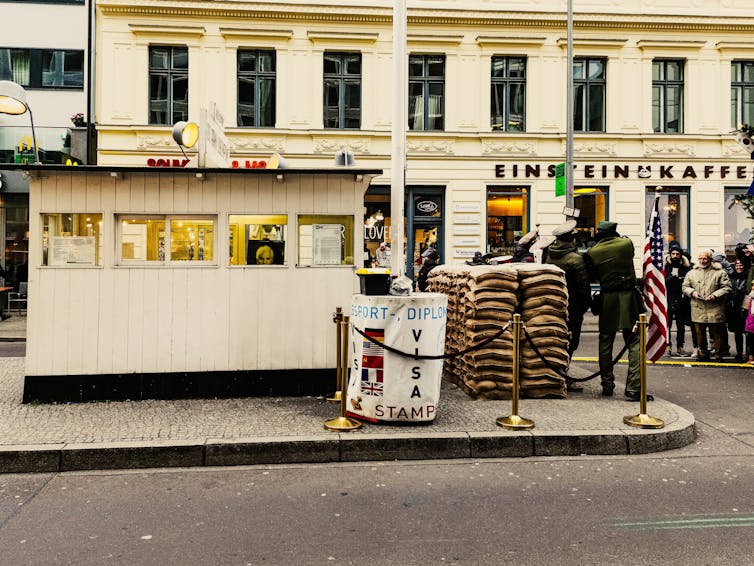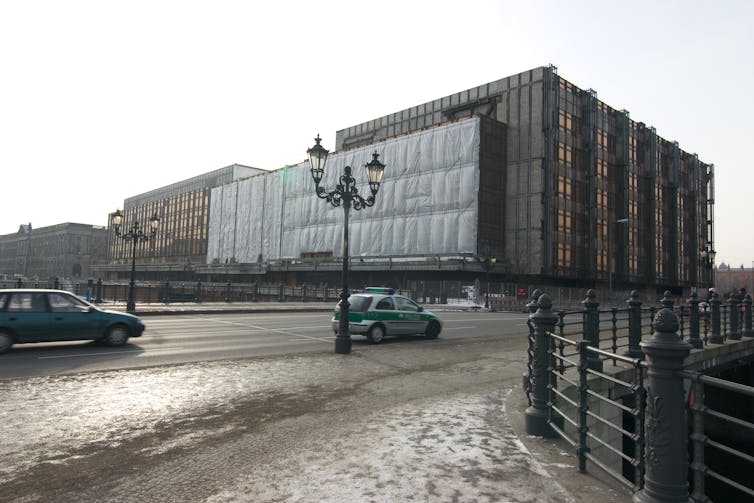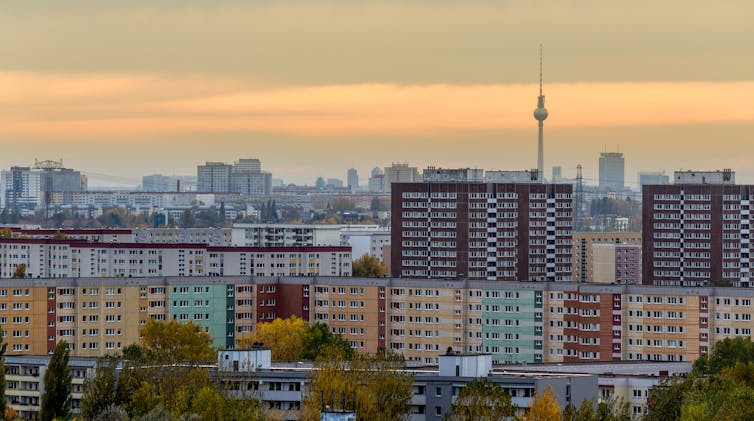Source: The Conversation (Au and NZ) – By Katrin Schreiter, Senior Lecturer in German and History, King’s College London
The 35th anniversary of the fall of the Berlin wall, an event that powerfully symbolised the collapse of communism in eastern Europe and signalled the end of the cold war, is an opportune moment to take stock of what remains of East Germany (GDR) in the capital of Germany.
Remnants of the wall in the eastern part of the city, most visible in the so-called East Side Gallery along the river Spree in Berlin-Friedrichshain, have become a tourist attraction. The former American border crossing, Checkpoint Charlie, likewise, is a highly frequented stop on Berlin’s sightseeing map.

FLickr/Richard Clifford, CC BY-SA
Many of the wall’s original concrete slabs were gifted abroad. A piece baring graffiti by artist Jürgen Grosse, known as Indiano, is on display outside London’s Imperial War Museum.
What remains of the wall in Berlin is a fading demarcation line. A trail of inscripted metal and simple cobble stones has people tripping over this part of German history – the 40-year division of the country and the “anti-fascist protection wall” that was meant to separate East Germans from the lure of the capitalist west.
However, the attentive tourist will note that the landmarks of the former GDR are gradually disappearing from the landscape of Berlin. Architectural heritage is falling victim to urban planners – and a specific political desire to frame the East German past in a certain way.
Shutterstock/ilolab
Not all asbestos is created equal
The most notorious example is the Palast der Republik, the glass, steel and concrete GDR parliamentary building and public event space. It was erected in 1976 on the site of the palace of the Hohenzollern, once home to imperial Germany’s ruling family, but ultimately destroyed in the war. The discovery of asbestos in the East German “people’s palace” in the 1990s made demolition a rational option. The deed was done in the early 2000s.

Shutterstock/
Bildagentur Zoonar GmbH
Funds could instead have been invested in repairing the building, had there been the wish to save this iconic architectural heritage of the GDR. But conservative forces drummed up political support for a highly controversial project to replace it – the partial rebuilding of the Hohenzollern palace.
Supporters emphasised tradition and the shared history of all Germans. Opponents point to the colonial crimes of empire. This discussion has continued since the new building houses the Humboldt Forum, a museum that is home to an “intercultural” collection of colonial exhibits that do not rightfully belong to Germany.
Meanwhile, the International Congress Centre, a conference complex in west Berlin that was also built with asbestos in the 1970s, has been listed for historical preservation.
Refurbished into political neutrality
In the meantime, the city has taken a different approach to other, more useful buildings such as the restructuring effort that has gone into the famous prefab plattenbauten – the large apartment blocks that dominate the urban landscape in the eastern part of the city.

Shutterstock/SebastianO Photography
According to the German Statistical Agency, between 1970 and 1990 the GDR built about 1.9 million apartments in blocks of this kind to combat a severe housing shortage. They attained cult status in the early 2000s, when it became fashionable among Berlin’s university students and young professionals to live in them. Concerns about sufficient living space in the growing capital justified the investments that the city put into the modernisation of these buildings.
But taking such a utilitarian approach to dealing with East German architectural heritage arguably robs buildings such as the plattenbauten of their political meaning. In being refurbished for future use, they are neutralised.
In recent years, a number of plattenbauten beyond Berlin have been listed for historical preservation. Only last month a similar step was announced for central Berlin. It includes houses in Münzstraße, Torstraße, Neue and Alte Schönhauser Straße and Dircksenstraße.
But anyone who is familiar with the area knows that buildings there were erected by East German urban planners during the “rediscovery” of Berlin’s architectural heritage in the 1980s. They emulate the style of turn-of-the-century apartment blocks and have nothing in common with the giant modernist plattenbauten that had helped in resolving the East German housing crisis.
Berlin, as the contested city of the cold war and the new seat of government in a reunited Germany, remains a challenged urban space. Whether or not there’s an explicit political agenda at work, conscious or unconscious biases among politicians inevitably come into play when they decide which buildings are allowed to stand and which are torn down.
![]()
Katrin Schreiter does not work for, consult, own shares in or receive funding from any company or organisation that would benefit from this article, and has disclosed no relevant affiliations beyond their academic appointment.
– ref. Thirty-five years since the wall fell, Berlin is divided – over what to do with crumbling communist buildings – https://theconversation.com/thirty-five-years-since-the-wall-fell-berlin-is-divided-over-what-to-do-with-crumbling-communist-buildings-242662








